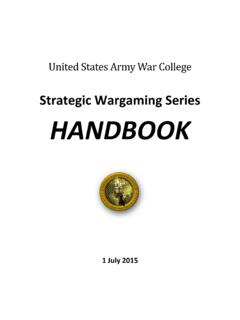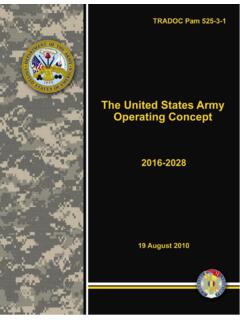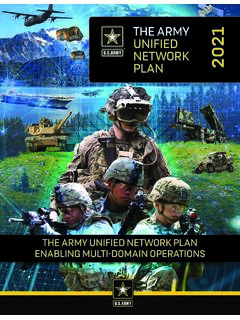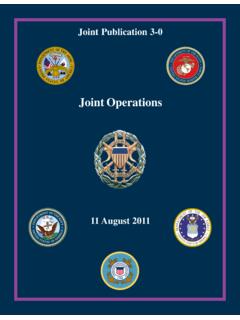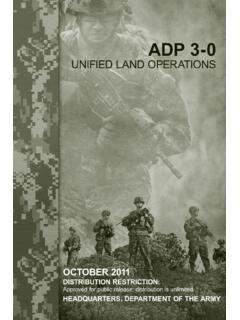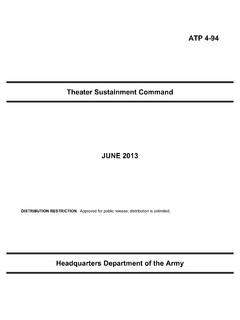Transcription of Strategic Cyberspace Operations Guide - Army War College
1 United States army War College Strategic Cyberspace Operations Guide 1 August 2021. Middle States Accreditation The army War College is accredited by the Commission on Higher Education of the Middle States Association of Colleges and Schools, 3624 Market Street, Philadelphia, PA 19104, (215). 662-5606. The Commission on Higher Education is an institutional accrediting agency recognized by the Secretary of Education and the Council for Higher Education Accreditation. Disclaimer: The systems, processes, and views described in this Guide reflect the judgment and interpretation of the editors, and does not necessarily represent the official policies or positions of the Headquarters, Department of the army , the Department of Defense, or the United States Government. The text is a synthesis and interpretation of existing National, Defense, Joint, and Service systems, processes, and procedures, and will be updated in accordance with changes in policy and doctrine.
2 Intentionally Blank ii Foreword 1. This publication provides a Guide for army War College students to understand design, planning, and execution of Cyberspace Operations at combatant commands (CCMDs), joint task forces (JTFs), and joint functional component commands. It combines Government Unclassified and Releasable to the Public documents into a single Guide . 2. This Strategic Guide follows the operational design methodology and the joint planning process (JPP) detailed in Joint Publication 5-0, Joint Planning and applies these principles to the Cyberspace domain found in Joint Publication 3-12, Cyberspace Operations . However, this publication is not to be cited, copied, or used in lieu of doctrine or other official publications. The army War College Strategic Cyberspace Operations Guide contains six chapters: Chapter 1 provides an overview of Cyberspace Operations , operational design methodology, and joint planning, and execution. Chapter 2 includes a review of operational design doctrine and applies these principles to the Cyberspace domain.
3 Chapter 3 reviews the joint planning process and identifies Cyberspace Operations planning concerns. Chapter 4 describes Cyberspace Operations during the execution of joint Operations . Chapter 5 provides an overview of Cyberspace Operations in the homeland. Appendix A provides an overview of Cyberspace policies, strategies, and guidance. Appendix B includes a description of Government, Department of Defense, Joint, and Service Cyberspace organizations. 3. This publication was compiled and edited by Professor Benjamin Leitzel and Professor Gregory Hillebrand. 4. Changes from the fourth volume (dated 1 June 2020) include the March 2020 Cyberspace Solarium Commission Report; President Biden's Interim National Security Strategic Guidance;. the May 2021 Executive Order on Improving the Nation's Cybersecurity; the July 2021 National Security Memorandum on Improving Cybersecurity for Critical Infrastructure Control Systems;. the 2021 Annual Threat Assessment of the US Intelligence Community; Commander US Cyber Command Congressional Testimony; and updates to Joint Doctrine.
4 5. This document is based on policy and doctrine and will be updated on a routine basis to reflect changes in guidance. We encourage comments to improve this Guide send recommended changes to: Center for Strategic Leadership ATTN: Strategic Concepts and Doctrine Division 650 Wright Avenue Carlisle, PA 17013. iii Intentionally Blank iv Table of Contents iii Table of Contents .. v Chapter 1: Introduction .. 1. Chapter 2: Design .. 3. I. Operational Design .. 3. II. Strategic Direction and Cyberspace .. 4. III. Cyberspace Strategic Environment.. 7. IV. Cyberspace Operational Environment.. 8. V. Defining the Problem: Threats and Challenges in Cyberspace .. 12. VI. Cyberspace Assumptions.. 22. VII. Cyberspace Actions and the Operational Approach.. 23. VIII. Identifying Cyberspace Decisions and Decision Points.. 28. IX. Refining the Cyberspace Operational Approach.. 28. X. Developing Cyberspace Planning Guidance.. 29. Chapter 3: Planning .. 31. I. Joint Planning Process (JPP).
5 31. II. Cyberspace Operations Planning .. 32. III. Cyberspace in Operations Orders ( army Doctrine) .. 38. Chapter 4: 41. I. Execution .. 41. II. Cyberspace Operations during Execution.. 42. III. Cyber Effects Request Format ( army Doctrine) .. 50. Chapter 5: Operations in the Homeland .. 55. I. Department of Defense Missions in the Homeland .. 55. II. Critical Infrastructure .. 56. III. Defense Critical Infrastructure Program .. 57. IV. Cyberspace Operations in the Conduct of Homeland Defense .. 58. V. Department of Homeland Security Cyberspace Responsibilities .. 64. VI. Department of Justice (DOJ) Cyberspace Responsibilities .. 65. Appendix A: Strategies, Guidance, and 67. I. Strategy and Policy .. 68. A. Cyberspace Solarium Commission Report .. 68. B. Interim National Security Strategic Guidance .. 70. C. Presidential Executive Order on Improving the Nation's Cybersecurity .. 72. D. National Security Memorandum on Improving Cybersecurity for Critical Infrastructure.
6 74. II. Department of State Cyberspace Policy .. 76. A. Joint Statement on Advancing Responsible State Behavior in 76. v B. Protecting American Cyber Interests through International 77. C. Deterring Adversaries and Better Protecting the American People from Cyber Threats .. 79. III. Department of Homeland Security Strategy and 81. A. The Cybersecurity Strategy for the Homeland Security Enterprise .. 81. B. Framework for Improving Critical Infrastructure Cybersecurity .. 83. IV. Department of Justice Cyber Strategy and Guidance .. 85. A. DOJ 2018 Report of the Attorney General's Cyber-Digital Task Force .. 85. B. FBI Cyber Strategy .. 86. V. Department of Defense Strategy and Guidance .. 88. A. DOD Cyber Strategy .. 88. B. Commander, USCYBERCOM Congressional Testimony .. 91. VI. Cyber Law Guidance .. 95. A. DOS Remarks on International Law and Stability in Cyberspace .. 95. B. DOD Domestic and International Cyber Law Considerations .. 104. C.
7 DOD Law of War Manual .. 111. Appendix B: Cyberspace Organizations .. 123. I. Department of State Office of the Coordinator for Cyber Issues .. 124. II. Office of the Director of National Intelligence Cyber Threat Intelligence Integration Center .. 125. III. Department of Homeland Security Cybersecurity and Infrastructure Security Agency (CISA) .. 126. IV. Department of Defense .. 127. A. National Security Agency/Central Security Service (NSA/CSS) .. 127. B. Department of Defense Chief Information Officer (DOD CIO) .. 129. C. Defense Information Systems Agency (DISA) .. 130. V. Joint Organizations .. 132. A. Cyber Command (USCYBERCOM) .. 132. B. Joint Spectrum Center (JSC) .. 133. C. Joint Communications Support Element (JCSE) .. 134. VI. Service Organizations .. 135. A. army Cyber Command (ARCYBER) .. 135. B. Marine Corps Forces Cyber (MARFORCYBER) .. 136. C. Navy Fleet Cyber Command (FCC) / TENTH Fleet (C10F) .. 137. D. 16th Air Force / Air Forces Cyber (AFCYBER).
8 138. E. Coast Guard Cyber 140. 141. vi Chapter 1: Introduction "While we are having success deterring conventional aggression against the United States, our adversaries are increasingly resorting to malign activity in less traditional areas to undermine our security, There is perhaps no area where this is more true than in the cyber domain.''. Dr. Mark T. Esper, Secretary of Defense 1 0F. 1. This Guide follows the operational design methodology and the joint planning process (JPP). and applies these principles to the Cyberspace domain. Cyberspace is a global domain within the information environment consisting of the interdependent networks of information technology infrastructures and resident data, including the Internet, telecommunications networks, computer systems, and embedded processors and controllers. Cyberspace Operations (CO) are the employment of Cyberspace capabilities where the primary purpose is to achieve objectives in or through Cyberspace .
9 2 Commanders must develop the capability to 1F. direct Operations in the cyber domain since Strategic mission success increasingly depends on freedom of maneuver in Cyberspace . 3 2F. 2. The President, Secretary of Defense (SecDef), and Chairman of the Joint Chiefs of Staff (CJCS) provide Strategic direction by communicating broad objectives and issue-specific guidance to the Department of Defense (DOD). It provides the common thread that integrates and synchronizes the planning activities and Operations of the Joint Staff (JS), Combatant Commands (CCMDs), Services, joint forces, combat support agencies (CSAs), and other DOD. agencies. It provides purpose and focus to the planning for employment of military force. Strategic direction identifies a desired military objective or end state, national-level planning assumptions, and national-level limitations. 4 At the operational level, joint planning translates 3F. national level guidance into specific activities aimed at achieving Strategic and operational objectives and attaining the military end state.
10 Plans translate the broad intent provided by a strategy into Operations ; successful Operations achieve the strategy's objectives. 5 4F. 3. Combatant commanders (CCDRs) use Strategic guidance and direction to prepare command strategies focused on their command's specific capabilities and missions to link national Strategic guidance to theater or functional strategies and joint Operations . The command strategy, like national strategy, identifies the command's broad, long-range objectives that 1 Jim Garamone, "Esper Describes DOD's Increased Cyber Offensive Strategy," linked from United States Department of Defense Home Page, 20 September 2019, strategy/. Joint Chiefs of Staff, DOD Dictionary of Military and Associated Terms (Washington, DC: Joint Chiefs of Staff, as of January 2021), 55. 3 Brett T. Willliams, "The Joint Force Commander's Guide to Cyberspace Operations ," Joint Force Quarterly 73, (2nd Quarter 2014), 12. 4 Joint Chiefs of Staff, Joint Planning, Joint Publication 5-0 (Washington, DC: Joint Chiefs of Staff, 1.)
